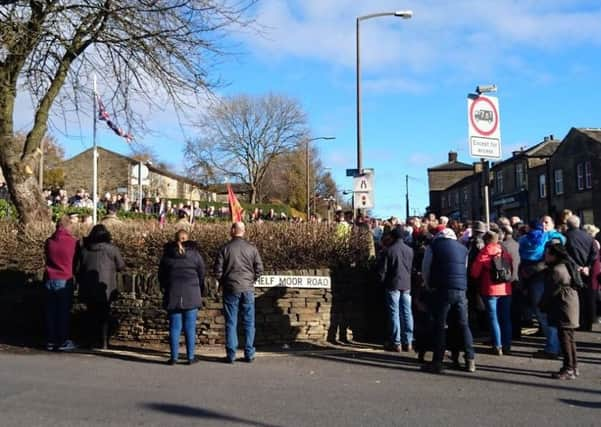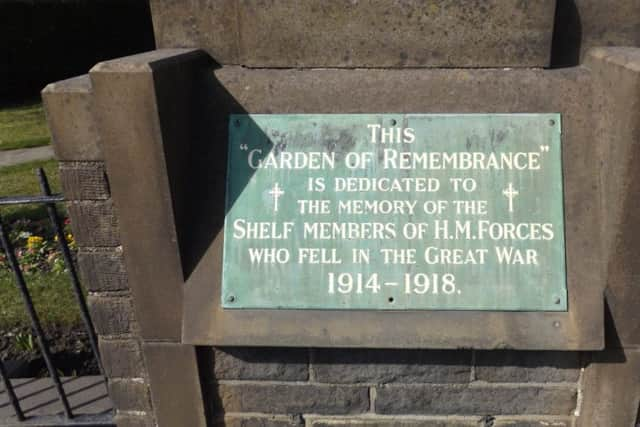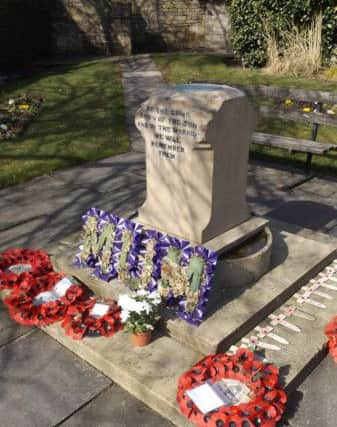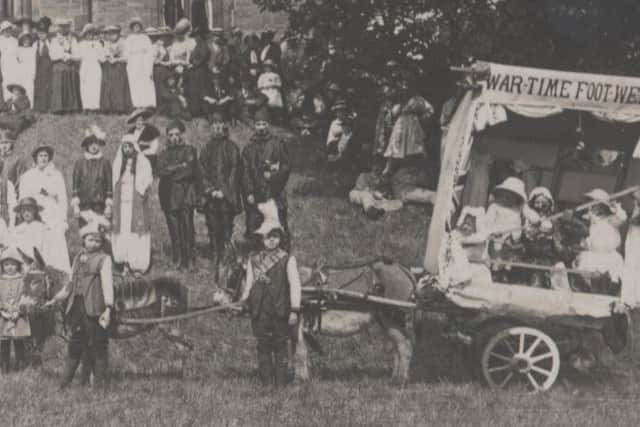Shelf during World War One


Marmaduke Holdsworth, the choirmaster at St Michaels Parish Church at Shelf, responded to the Boer War (1899-1902) with a hymn entreating God to intervene, whilst revealing some of his own insecurities about the war:
“Grant, Lord that soon this war shall end
And perfect peace return once more,


And nations nevermore contend”
As it transpired, a much bloodier and deeper reaching conflict was on the horizon. On the 4 August 1914, War was declared with Germany. The conflict would touch everyone in the village, and everyone would have known at least one of the soldiers killed or their family.
Advertisement
Hide AdAdvertisement
Hide AdThe war had some other effects on life in the area, in 1917, an aeroplane landed at Cooper Lane, and the fascination for the young scholars was such that they had to be fetched away to attend school, and later an airship passed overhead in 1919.
Schools were involved in fund raising and sending eggs to wounded soldiers. War savings funds were also set up in some of the mills and at the council school, encouraging people to buy bonds that would benefit both the government and themselves.


Social evenings and other fundraising events were held. The employees of Hind and Co. of Shelf Mills held a ‘social’ in the Church School in January 1916. Music (piano and violin) was provided for dancing and £9 was raised to be split between the Belgian Relief Fund and Shelf Distress
Fund.
A large part of Shelf Woods was felled to provide much needed timber, and the tender flowers at Shelf Hall’s conservatory didn’t survive the winter frost due to fuel rationing. Towards the end of the War, Shelf Urban District Council were somewhat short sighted in fixing the price of milk higher than Bradford and almost all the other local villages.
Advertisement
Hide AdAdvertisement
Hide AdHowever they proved themselves somewhat forward thinking when they declared that decimalization of coinage was “;not only desirable but absolutely essential that it should be adopted” in 1916. A reporter at the Bethel Sunday School annual Whitsuntide treat in June 1916 reported that “the absence of young men was very evident, many having been called upon to serve their country elsewhere”. However, some local men were exempt from the prescription, having “certified


occupations” such as in schools or on farms. This was decided by a local “Shelf Tribunal”.
One Shelf man (aged 23), a conscientious objector who had been a wool sorter, was handed over to a military escort and stated that “he did not acknowledge the charge against him”, that of evading military service.
As the war progressed, news filtered through of deaths during the conflict. Bombardier Charlie Hanson of Green Lane joined up in October 1914, prior to which he was a wool sorter at Bottomley’s Mill in Buttershaw. In July 1916, his fiancée Miss Ackroyd received a letter from two of his friends in the trenches:
Advertisement
Hide AdAdvertisement
Hide Ad“It is with deepest sympathy that we have to inform you that Charlie was killed yesterday, whilst doing his duty. He was struck by a shell whilst sitting under a parapet in the trenches and was killed instantaneously, suffering no pain. We were unable to get his belongings from him. He was well liked by all, and we trust you will accept our greatest sympathy.”
He was connected with Bethel Chapel and the same day the letter arrived, another had been delivered from Charlie to his friends at Bethel thanking them for a parcel he had received.
The Battle of the Somme raged from July to November 1916, the Shelf casualties might include Charlie Hanson and Fred Woodhead. Private Willie Mitchell was reported missing at Somme but it was only discovered that he had been killed there by a shell some months later.
There were a number of reported severe injuries, including George Gledhill of Shelf Moor, Campbell Holdsworth of Brow Lane, Edgar Petty of Riding Hill and Harold Foulds. Lieutenant W B Taylor of Green Lane survived being wounded at the Somme but was killed after he rejoined his regiment in 1917. Harold W Rhodes died of a bayonet wound received in action on Easter Monday 1917, probably during the Battle of Arras.
Advertisement
Hide AdAdvertisement
Hide AdCorporal John Hanson Shaw was killed at Ypres in 1915, and his Lieutenant Harold Shaw died at Esquelbecq in 1918, about 15 miles from each other. The war was raging further afield than France. Captain Taylor, who had worked at Shelf Sanatorium, was wounded at Sheikh Sa’ad in modern day Iraq in 1916 and returned home.
For many of the bereaving families, they had no grave to visit. Only a handful of the Shelf soldiers were to be buried in their home village.
Private Fred Whittaker, formerly a greengrocer of Cross Lane, was wounded in France and invalided home. He died at Wharnecliffe War Hospital in Sheffield on 31 st October 1917. His funeral, was one of only a few held in the village for the war dead, and when the hearse passed through the village on its way to Bethel Chapel “all along the way through Stone Chair and Shelf the blinds were drawn, showing the deep respect with which he was held.”
Some soldiers were invalided ‘home’ for treatment, and their relatives could be given passes to allow them to travel to the various war hospitals around the country. Shelf Sanatorium, which opened in 1914 for patients with tuberculosis, was used for recuperating soldiers. At Christmas 1916, the Sanatorium wards “were decorated with festoons of evergreens” for a musical concert for “the inmates, several of whom were unable to leave their beds.”
Advertisement
Hide AdAdvertisement
Hide AdSergeant Adams, a patient of the Sanatorium who was recently invalided home from Gallipoli, provided “uproarious merriment” with his appearance as “a love-sick lady appealing to the Matron for her ‘Edwin’ and carrying him off”.
Whilst the war dead were to be memorialised both in the village and abroad, many of the other local soldiers who survived the conflict are less easy to trace. Besides the painful stories around soldiers from Shelf, there were also stories of great bravery and strength in the direst of circumstances.
In 1918, Corporal Wilson Barker, an only child from Cock Hill Lane, was awarded the Military Medal for gallantry. He worked as a runner and “during the advance, he constantly carried messages to the forward platoons under the heaviest machine gun and rifle fire, showing the utmost fearlessness” on one occasion even carrying a supply of bombs with him.
The various War Memorials of Shelf’s Churches and Chapels record the names of 81 young men who died in the Great War. The plaque at St Michael’s has 48 names, with a further 15 for Witchfield Chapel, 13 for Bethel Chapel and 5 for Wade House Chapel. Stained glass windows at St Michaels commemorate the war dead and act as “a thank offering for others who returned” depicting the Angel of Peace and St George sheathing his sword. Another window was installed in memory of John Hanson Shaw and Harold Shaw; the two brothers from Shelf who were killed in France, both windows were unveiled in 1920. The Village War
Memorial was completed after seventeen years of discussion, and unveiled on the 28 September 1935.